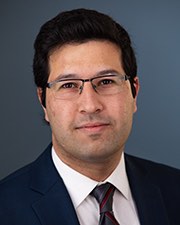Professor Receives Funding from Sony to Develop Millimeter Wave Networking Technology
 Sony Corporation of America is supporting Assistant Professor Morteza Hashemi to develop novel multi-hop routing protocols for millimeter wave (mmWave) communication systems.
Sony Corporation of America is supporting Assistant Professor Morteza Hashemi to develop novel multi-hop routing protocols for millimeter wave (mmWave) communication systems.
By 2022, global data traffic generated annually by mobile devices is projected to surpass 900 exabytes. To address the spectrum congestion that cellular providers are already experiencing, mmWave bands—between 30–300 GHz—are expected to play an important role in 5G systems. These new bands will be able to provide data rates beyond multiple gigabits per second. However, reliable communication at mmWave frequencies is challenging due to variable channel conditions and intermittent connectivity. Also, the propagation loss is much higher due to a variety of factors, including atmospheric absorption and low penetration. For indoor applications, mmWave propagation suffers from blockage even when a person crosses the line-of-sight.
Photo: EECS Assistant Professor Morteza Hashemi.
To mitigate these issues, multi-hop communication at mmWave frequencies is a promising technology in order to enhance reliability and quality of service. Current multi-hop protocols, however, are not designed for mmWave bands and they fail to take into account various aspects, such as intermittent connectivity, directional communication, and mobility. The overreaching goal of this project is to develop dynamic multi-hop protocols running over directional mmWave MAC and PHY layers and demonstrate the benefits and viability of such protocols to mitigate inherent mmWave channel impairments, such as human blockage.
“This research has the potential to make a big impact on future wireless networks and we are excited to begin this collaboration,” Hashemi said. The project is funded by the US Research Center of Sony.